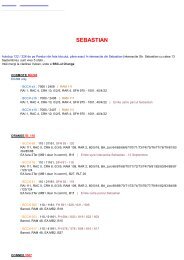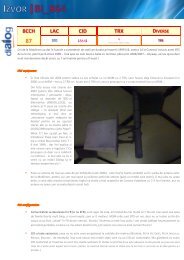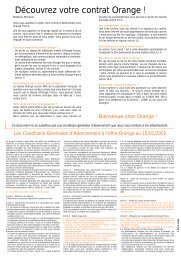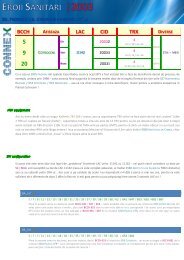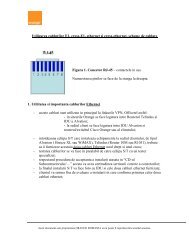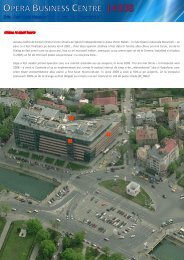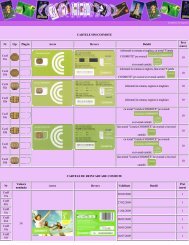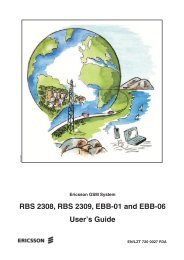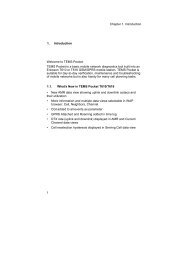BSS Description B10 (3FL10473A-ed 2)
BSS Description B10 (3FL10473A-ed 2)
BSS Description B10 (3FL10473A-ed 2)
Create successful ePaper yourself
Turn your PDF publications into a flip-book with our unique Google optimized e-Paper software.
1. Evolium <strong>BSS</strong> Introduction<br />
Telecom Features<br />
ALCATEL <strong>BSS</strong> <strong>Description</strong> 28<br />
Features defin<strong>ed</strong> in the GSM recommendations<br />
Cellular Environment<br />
Frequency Hopping<br />
Radio Frequency hopping<br />
Base Band Frequency hopping<br />
Radio Power Control uplink and downlink (BTS / MS)<br />
Discontinuous Transmission (DTX)<br />
Discontinuous Reception (DRX) (MS)<br />
Call Re-establishment by MS<br />
Enhance Full Rate (EFR)<br />
Adaptive MultiRate codec (AMR)<br />
Tandem Free Operation (TFO)<br />
Multiband operation<br />
Multiple CCCH<br />
EVOLIUM<br />
ALCATEL <strong>BSS</strong> <strong>Description</strong><br />
All Rights Reserv<strong>ed</strong> © Alcatel-Lucent 2008<br />
Cellular environment: define different types of cell configurations to meet the requirements of<br />
geography and the strategies of the Network Operator.<br />
RPC uplink and downlink: ensure the dynamic balance between the quality of the radio link in both<br />
directions (i.e., uplink and downlink), against interference with other cells. It also contributes to<br />
power conservation.RPC is achiev<strong>ed</strong> through BTS Radio Power Control and MS Radio Power Control.<br />
Discontinuous Transmission/Voice Activity Detection:decrease the average interference level generat<strong>ed</strong><br />
by the network in both the uplink and downlink directions. This feature, in association with FH,<br />
significantly improves spectrum efficiency without jeopardizing the quality of the telephony service.<br />
Discontinuous Reception:conserve battery power by allowing the Mobile Station to switch off its receiver<br />
and data processing in the idle mode. This occurs except for the short time when the Mobile Station<br />
expects a message from the BTS. The Mobile Station only listens to that part of the paging channel<br />
corresponding to its paging group.<br />
Call re-establishment by the MS: re-establish a connection in progress after a lower layer failure.<br />
Enhanc<strong>ed</strong> Full-Rate: allow the use of codecs with an improv<strong>ed</strong> speech encoding algorithm, which<br />
provides enhanc<strong>ed</strong> speech quality on full-rate channels<br />
Adaptive MultiRate codec (AMR): Adaptive Multi-Rate is a new codec defin<strong>ed</strong> by ETSI. This technology<br />
relies on a set of pre-defin<strong>ed</strong> "codec modes" (AMR-FR and AMR-HR), each one providing optimum<br />
performance under specific radio conditions.<br />
Tandem Free Operation (TFO): TFO provides a better voice quality by avoiding unnecessary successive<br />
coding and decoding operations in the case of mobile to mobile calls. TFO is therefore a feature of<br />
great importance, as the percentage of mobile to mobile calls increases with the number of<br />
subscribers.<br />
Multiple CCCH: to increase the signaling bandwidth on the Air interface, 3GPP defines up to 4 time slots<br />
to carry the CCCH information (TS0, TS2, TS4 and TS6). The Alcatel-Lucent solution supports multiple<br />
CCCH on TS0 and TS2 in G2 BSCs and MX BSCs.<br />
All Rights Reserv<strong>ed</strong> © 2007, Alcatel-Lucent<br />
<strong>3FL10473A</strong>DAAWBZZA Edition 02<br />
EVOLIUM ALCATEL <strong>BSS</strong> <strong>Description</strong> Page 28




